|
Further Speculations on the Secrets of
The Templars, The Inklings, Nikola Tesla and
Rennes-le-Chateau
Part Two
It does nothing to distance Nikola Tesla or his science from these
mysteries. One does wonder how much of an inspiration to Tesla that
John Napier might have been, and how many of Teslaís secret dreams
may have leaked out through the pages of the Inklingsí stories. The
Fanthorpeís discussion of Napier includes descriptions of things,
even terrible ones, which sound even more like Teslaís science,
which died with him. Should we presume Napier so jaded as to only
have attended the task of horrendous death machines, or might we
presume that he, like Tesla, had been even more concerned with the
peaceful applications of the very same knowledge?
Perhaps the reason that the Rennes-le-Chateau mystery have come to
light is that it was allowed to come to light, and only when the
knowledge had finally surfaced independently into the mainstream,
leaving nothing else for the Prieure to conceal, nor any point in
trying to conceal it.
If one correctly guesses the other possible outcome of the C. S.
Lewisí "The Magicianís Nephew" with the entry of its characters into
the second alien world, suffice it that the extremely Martian theme
of a dead, barren world, encountering a lion that magically
populates worlds with life has far too close to the other Martian
theme of magically restoring life to that long dead world. What
Lewis has said when one gets to reading his work, is apparently no
different than what I have said may have been expected of the
dreams, ambitions, and knowledge of the Templars.
Ultimately, the subject of the signs of ancient knowledge possessed
by the Templars and the Priory of Sion that shine out through the
pages of the Inklingsí works is a subject worthy of an entire work
in itself- especially when thereís such a strong suggestion that the
precise details of this knowledge have been included in these
fiction works.
Certain other "coincidences" arise; the cover of the edition of "The
Magicianís Nephew" which I have purchased seems to show an orchard
of what could be taken to be
blue apples, though the silver apples
which the story actually contains remain close enough for practical
purposes; still the grapes which the Fanthorpes offer considerable
corroboration for as a candidate for the meaning of this cryptic
expression appear in a similar position and context in Lewisí story,
and remain even more outstanding because of the peculiar way and
time at which they enter the story, so as to appear an annoying
trifle were there not through this gesture great emphasis on their
true importance.
Secret watermark codes from various sources, many of which were
frequently used by Francis Bacon, from the Fanthorpesí riveting
book, "Secrets of Rennes-le-Chateau", pgs. 92-93.
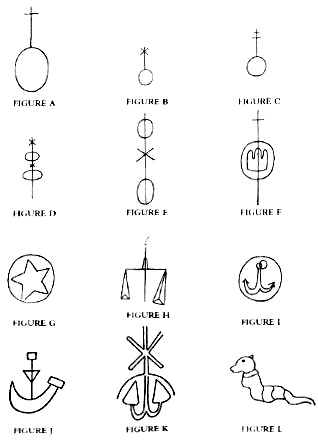
They observe the similarity of some of the last ones (N) to the
Inkling Tolkienís drawing of the gates of Moria. Such symbols and
possible connections should be given much more attention, and the
application of a work such as Harold Bayleyís "The Lost Language of
Symbolism" to the problem of the watermarks represents only a
beginning.
What I would already like to suggest, however, is how apt many of
these are to be symbols of ancient atomic science; figures D, E, and
F have striking similarity to the precessional models of planets and
the atom which underlay the ancient magickal miracle sciences, and a
number of these concern literal archetypes in the ancient science of
materialization, such as figure H and far less disputably figure N.
Figure M also has a substantial graphic indicator of precession on
an axis.
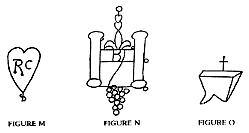
Figure N combines the precession with the vorticular motion expected
between the columns of Boaz and Jakin, which I have given much
attention to on my page on "Magical Vortex Science". The clustering
of grapes in this context serves to symbolize the clustering of
atoms, the materialization that is theoretically possible with this
configuration through the introduction of holographic data into the
basic electrochemical processes. One should not understate the
possible importance of conjunction of symbols for precession and for
vortices.

Figure E has the potential, as do the mythological references in
C.
S. Lewisí works, to tie together a great deal of symbolism, for the
crown here seems to symbolize a muon orbital around an atom. A-E are
all capable of illustrating how the cross serves as a symbol of the
cardinal, magnetic points of the compass, hence magnetism, and some
of them simultaneously integrate the archaic predecessors of our
modern elemental and chemical symbols for phosphorus. Figure I has
strong resemblance to what is increasingly appearing to be a
universal symbol for concerns such as ectoplasm and matter that is
extracted from the ground for various miraculous and supernatural
feats. The use of a dogís head may reinforce the "buried" matter,
since "dogs dig, and bury bones"; it may likewise, as a number of
animal symbols seem to, suggest certain elements.
An association between the dog symbol and phosphorus, for example,
can be made because of not only that it is bones (calcium phosphate)
that dogs bury, but because the urine of certain animals can be
associated with elements that are predominantly present. This fact
underlies the use of animal urine in modern plant foods. This
symbolism may date back to the Egyptians, who make the canine Anubis
present along with Thoth in the form of the blue ape, in the scenes
of the Balance that so strongly suggest it to be an ancient
materialization device. Note that the balance has not escaped
inclusion here.
Letís move on now to some of the other persons who have been
associated with the mystery.
Of the mysteries of Rennes-le-Chateau themselves, even while the
Fanthorpe work is scarcely showing signs of being able to follow the
clues to a logical conclusion, theyíve laid a remarkable number of
the important pieces in place, and even more so, must possess an
uncanny gift for noticing things of importance without necessarily
knowing why, to rival or exceed that of the continually-criticized
Erich Von Daniken, gifts that in fact should call for considerable
commendation.
The theme that is found in Sauniereís church, for example, of
gambling for Christís garments, and the Pythagorean mathematics that
is communicated by its use of the numbers 3, 4, and 5 appearing on
the dice, is an interesting work to find
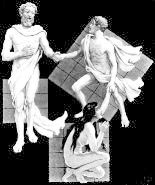  highlighted where there is
much hidden geometry and the merits of the
Emerald Tablet have also
been brought into question, for a standard occult sourcebook, Manly
Palmer Hallís "Secret Teachings of All Ages" gives some intriguing
captions to an illustration, that might link the Hermetic riddle
with the Pythagorean mathematics, when the Emerald Tabletís riddle
already seems to be able to be linked with the concerns of the
predictable upwellings of energy on planetary and solar bodies. highlighted where there is
much hidden geometry and the merits of the
Emerald Tablet have also
been brought into question, for a standard occult sourcebook, Manly
Palmer Hallís "Secret Teachings of All Ages" gives some intriguing
captions to an illustration, that might link the Hermetic riddle
with the Pythagorean mathematics, when the Emerald Tabletís riddle
already seems to be able to be linked with the concerns of the
predictable upwellings of energy on planetary and solar bodies.
In essence, the requisite application of mathematical formula could
be found in this way, if it cannot be found in any other. However,
Richard Hoaglandís observations, and those of many who have attended
the mechanics of the planetary energy grids have already long since
included the Platonic solids, including their occurrence amongst the
knowledge of many ancients.
Another way of looking at this may include what the Fanthorpes say
of this precisely:
"just as 3 squared + 4 squared equal 5 squared,
so 3 cubed + 4 cubed + 5 cubed = 6 cubed (6x6x6). All very curious!"
Perhaps not. Although 666 is "normally" the
 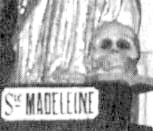 number of the
ancient khamea (E.A.W. Budge, "Amulets and Talismans"), or "magic square"
that the Egyptians used to represent the sun, Richard Hoagland has
mentioned that the infamous "666" can be interpreted as a previous
666 day period of the planet Mars, that Mars "is" "the Beast". number of the
ancient khamea (E.A.W. Budge, "Amulets and Talismans"), or "magic square"
that the Egyptians used to represent the sun, Richard Hoagland has
mentioned that the infamous "666" can be interpreted as a previous
666 day period of the planet Mars, that Mars "is" "the Beast".
Considering the amount of interplanetary material, particularly
Martian material, tucked into the Major Arcana and other cards of
Aleister Crowleyís "Thoth" Tarot deck, it is not at all wild
speculation for Mr. Hoagland to be saying that this is what
Crowley
himself intended by the use of this expression. Itís consistent in
fact with Crowleyís "precocious" statement in the Book of Thoth that
the force that moves a dowsing rod would someday take man to the
stars.
Interesting also, perhaps, if we take 2,3,4 as another form of 3,4,5
and 4,5,6 - even though it does not have this consistency, we have
nonetheless named the planets in the solar system where C. S. Lewisí
fictions have placed life and civilizations (and then some, as we
shall soon see later in this work).
Another striking feature of Sauniereís peculiar church is the
appearance of the skull. What it suggests of course is a throwback
to earlier signs of the alchemists and the Christians alike that
make Christ out to be predominantly a cognate of the symbol for
phosphorus, often in a way that describes the way in which this
element and its kindred are pertinent to the alchemic art of palingenics,
resurrection or materialization. This is merely another
way of linking Christ with the Phoenix, a feat that is possible
through many similarities, and the Phoenix in turn is an alchemistís
symbol of palingenics. It also serves as a bit of an indication that
the Templar secrets included the making of artificial intelligence
in the form of oracular heads.
The Fanthorpesí work in fact also touches on a similar theme, in the
form of both oracular or artificial beings. (pg. 119):
"Another
theory suggests that the word "Baphomet" is formed from
Baphos and
refers to water. The Baphomet of the Templars, according to this
theory, was a magical severed head, covered in gold leaf or bronze,
and able to utter accurate oracles when questioned in conjunction of
the performance of the appropriate rites an incantations. This head,
once John the Baptistís (hence Baphos), had been taken from Herodís
place after being stuck off to gratify Salome. It has been suggested
that, recognizing the latent oracular power of so potent a relic, a
member of the Priory of Sion rescued the head and preserved it in
gold leaf in a casket packed with magical herbs and spices...".
While such the necessity of such a deed is virtually ludicrous
considering that the technological standards of the mystery schools
allows prophetic objects to be constructed of any stone lying on the
ground, the basic message of the anecdote is a poignant one. The Fanthorpes continue,
"The Templars were certainly accused in the
wilder rumours spread by their opponents of taking profane orders
from a supernatural brazen head that spoke miraculously."
On pg. 176, we find a repetition of the same theme:
"Spencer argued
etymologically that the Urim were the same things as the Teraphim-
miniature anthopomorphic idols, rather like dolls [Some at least
must have been life-sized, for Michal (Davidís first wife)- and the
daughter of King Saul) to use one for the "dummy in bed" trick to
conceal Davidís escape from Saul (1 Samuel 19:11-17)...] which is
both reasonable and possible. He went on to speculate, however, that
there was some strange supernatural means by which these images were
made to speak to the Priest, which seems infinitely less likely."
The Fanthorpe text of course does not take into consideration both
the wealth of clues from ancient cultures demonstrating their facile
and modern understanding of acoustic energy as unified with other
forms, and understanding that readily enables giving such oracles
the "magickal" gift of speech, nor the ancient familiarity with the
fundamental physical configuration that we today employ for the
audio speaker. Such forms are not only found amongst Tutankhamenís
pectorals, they are found in a context that undeniably links them
with knowledge of their value as it relates to sound, in the
ear-rings of ancient South America. Also, as we will see within this
work, the necessary science to transduce sound from other forms of
energy for this purpose and others is not only central to the
science of Nikola Tesla, who they loosely associate with the
Rennes-le-Chateau
mystery, and relatively simple and straightforward for the science
in question, but this itself in turn at times appears to be central
to the mysteries of the Inklings.
One of perhaps the most intriguing elements of Sauniereís church is
the rendition of the "demon", possibly Asmodeus.
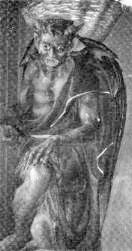 Behind him, there
is clearly a vortex. Carefully studying the diverse accounts of palingenics should suggest that this is used as a symbol for both
the vortex that is purged from the ashes prior to resurrection, and
the affiliation with the title, "Rex Mundi" recalls the
familiar
premise that what is purged is an expression of the thermodynamics
of a large planetary body (cf. Daneri-Loinger-Prosperi paper on
collapse of the wave function by thermodynamics of large bodies &
ref. in Nick Herbert, "Quantum Reality"), most prominently and
probably that of the earth itself. Given the iconography of similar
concerns in the mysticism of
Carlos Castaneda, and in turn the
ancients, we are hardly surprised to next encounter the symbolism of
an eagle to enter the discussion soon after. Behind him, there
is clearly a vortex. Carefully studying the diverse accounts of palingenics should suggest that this is used as a symbol for both
the vortex that is purged from the ashes prior to resurrection, and
the affiliation with the title, "Rex Mundi" recalls the
familiar
premise that what is purged is an expression of the thermodynamics
of a large planetary body (cf. Daneri-Loinger-Prosperi paper on
collapse of the wave function by thermodynamics of large bodies &
ref. in Nick Herbert, "Quantum Reality"), most prominently and
probably that of the earth itself. Given the iconography of similar
concerns in the mysticism of
Carlos Castaneda, and in turn the
ancients, we are hardly surprised to next encounter the symbolism of
an eagle to enter the discussion soon after.
This vorticular motion, however, may sooner strike the seeker as
that vorticular fluid flow that is prominent at the "magic
latitudes" predicted by Richard Hoagland, even though sooner or
later it is also contended with at the atomic level in the ancient
wisdom in question. The whirlwind in the alchemistís flask, in fact,
seems to suggest a collective (quantum?) state of the vorticular
powers of the individual atoms, replete with their coherence at a
larger level of scale of reality.
The idea of "Rex Mundi" also relates to the "Axis Mundi", which for
these concerns is both the axis of precession, and the earthís
magnetic axis. There is the same implication in that that there may
be in Tolkienís drawing of the Gate of Moria (see watermark N,
above). There is no shortage whatsoever of archaic figures of Christ
and many other persons who seem to be holding their staff at the
exact angle which the true magnetic north polar axis deviates from
the geographical polar axis, concerns which may have entered Lewisí
first book in the "Chronicles of Naria" series in a whimsical and
casual yet complex manner, the form of the appearance of
Father
Christmas.
In the decoded cipher that is of central importance to the mystery
of Rennes-le-Chateau,
"SHEPHERDESS NO TEMPTATION TO WHICH POUSSIN AND TENIERS KEEP THE KEY
PEACE 681 WITH THE CROSS AND THIS HORSE OF GOD I REACH THIS DEMON
GUARDIAN AT MIDDAY
BLUE APPLES",
...there is sufficient ambiguity that, even though there are good
possibilities of firmly nailing down the more bizarre expressions to
facets of the treasure of the knowledge of the alchemists, the
actual references to persons and works is not necessarily quite so
easy. This must even withstand the fact that there are claims that
the "Horse of God" has been identified with a certain stone on the
landscape of the area; there is much to suggest that the "treasure
map" of Rennes-le-Chateau is indeed working on more than one lofty
level at once, as if in celebration of the Hermetic Axiom, "as
above, so below", but certainly consistently typical for the
expressions of ancient wisdom.

Poussinís painting with the "treasure map" geometry superimposed;
also superimposed is the sacred geometry, including at least one
pentagram, which can be discerned in the center of the work. Other
sources refer to pentagonal geometries here of which the picture is
only large enough to contain part. The skyline here is painted from
a real one, thatís part of the clue. How many of Poussinís other
intriguing skylines, or even those of his imitators, may be in fact
real ones? What secrets might they yet conceal?
There is no telling that only one or two works implied in this
phrase are relevant. Poussinís work referred to here has been
identified as possessing both the hidden geometry of a treasure map,
and the hidden sacred geometry of the pentagon, but in fact the
occurrence of hidden sacred geometry in artworks may be far more
prevalent, as familiarity with John Mitchellís "View Over Atlantis"
implies. In fact, one of the things that may eventually prove to be
true, is that in regards to the mystery cipher as it involves
alchemy, is that many paintings depicting St. Anthonyís Temptation
may contain relevant clues.
The possibility that many or even all of the painters who in that
day had painted the Temptation may have been mystical initiates may
be the very reason for the inclusion of a clue almost too vague and
too broad to be of use otherwise.
Likewise, there is no real reason to automatically restrict the
relevancy of the works of Poussin and Teniers to those works
mentioned. Itís difficult to believe that they could have easily
been contracted to do even this much work without being initiated,
or they may have been commissioned because they were already
initiates. It would perhaps be hard to trust them with the clues to
any treasure they incorporated into this art without them having
already been privy to the greater treasure, but certainly virtually
all of their work may contain the very same sorts of clues, whether
or not to more material treasures, certainly there is the
possibility that they embody further references to the treasure of
priceless knowledge.
While it is not firmly established through mathematical studies, I
record here my observation that the irregular use of squares that
seems to be present in Poussinís work - even his self-portrait
- in
spite of the pentagonal and triangular geometry that may be
superimposed on much of it, may be hinting at some geometry that may
prove to be that of the hypercube, and quite possibly for those far
greater purposes than simply hinting at the structure of the key to
Sauniereís cipher.

The hypercube, a tesseract, an example of hyperdimensional geometry.
Itís a strong link between the mystery of Rennes-le-Chateau and the
physics coming from the mathematical and geophysical messages of the
Martian monuments, another link between the Templars and
Mars.
This, however, isnít nearly the end of the mystery; while we can
guess that the greatest ambition of the Templars may have been to
create a riddle whose answers tie a Gordian knot through everything
that is immediately relevant to the mystery, in such a way that it
unlocks the mysteries of the ages and justifies the individual
elements of the solution, itís barely the beginning.
Regardless of whether or not the aim of this diverse brotherhood was
to leave a legacy that seduced the treasure seeker and the
fantasy-minded into the web of ancient knowledge, there remains
still so much more ground to cover...
Back To Contents
|




 highlighted where there is
much hidden geometry and the merits of the
highlighted where there is
much hidden geometry and the merits of the

 number of the
ancient khamea (E.A.W. Budge, "Amulets and Talismans"), or "magic square"
that the Egyptians used to represent the sun, Richard Hoagland has
mentioned that the infamous "666" can be interpreted as a previous
666 day period of the planet Mars, that Mars "is" "the Beast".
number of the
ancient khamea (E.A.W. Budge, "Amulets and Talismans"), or "magic square"
that the Egyptians used to represent the sun, Richard Hoagland has
mentioned that the infamous "666" can be interpreted as a previous
666 day period of the planet Mars, that Mars "is" "the Beast".
 Behind him, there
is clearly a vortex. Carefully studying the diverse accounts of palingenics should suggest that this is used as a symbol for both
the vortex that is purged from the ashes prior to resurrection, and
the affiliation with the title, "Rex Mundi" recalls the
familiar
premise that what is purged is an expression of the thermodynamics
of a large planetary body (cf. Daneri-Loinger-Prosperi paper on
collapse of the wave function by thermodynamics of large bodies &
ref. in Nick Herbert, "Quantum Reality"), most prominently and
probably that of the earth itself. Given the iconography of similar
concerns in the mysticism of
Behind him, there
is clearly a vortex. Carefully studying the diverse accounts of palingenics should suggest that this is used as a symbol for both
the vortex that is purged from the ashes prior to resurrection, and
the affiliation with the title, "Rex Mundi" recalls the
familiar
premise that what is purged is an expression of the thermodynamics
of a large planetary body (cf. Daneri-Loinger-Prosperi paper on
collapse of the wave function by thermodynamics of large bodies &
ref. in Nick Herbert, "Quantum Reality"), most prominently and
probably that of the earth itself. Given the iconography of similar
concerns in the mysticism of

